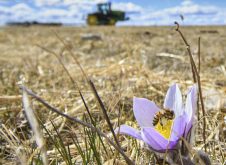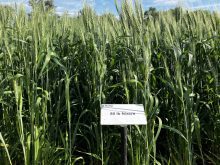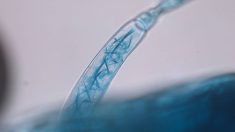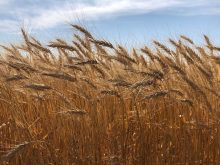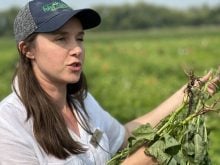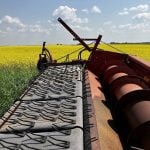Canadian agriculture is being pushed to look for a new balance in terms of its nitrogen emissions.
Nitrogen is a critical nutrient, essential to life and agriculture, but its byproduct, nitrous oxide (N2O), is also a powerful greenhouse gas, emissions of which the federal government has aimed to slash.
Canadian agriculture is now several years into the federal goal to reduce N fertilizer emissions by 30 per cent below 2020 levels by the end of the decade. Similar regulations have caused tension in the European Union and elsewhere.
Read Also

How much nitrogen can farmers really cut?
Manitoba fertilizer trials seek a sweet spot where farmers can cut nitrogen rates, with a nitrification inhibitor, without hurting yield and with fewer greenhouse gas emissions.
Kate Congreves, a University of Saskatchewan associate professor, has been researching how to improve crop production while limiting nitrogen emissions as part of the second Diverse Field Crops Cluster (DFCC). The most recent five-year cluster started in 2024.
Preliminary results keyed in on the mix of different application techniques and products that resulted in more efficient nitrogen management.
READ MORE: Rethinking nitrogen efficiency
“Nitrogen fertilizers are the largest source of anthropogenic N2O emissions,” she said during a March presentation.
“What this means (is), if fertilizers and fertilizer applications are a large source of N2O emissions, anthropogenic N2O emissions, that means our adjustments to fertilizer and fertilizer management do have an impact on reducing emissions.”
DFCC focuses on research on diverse crops such as camelina, carinata, flax, sunflower and mustard. Spring wheat is tapped as a control.
One of her hopes is to identify “double wins” — that is, the high-value crops associated with the lowest emissions.
Win-wins
The project builds on nitrogen emission test results and practices established in Nitrous Oxide Emission Reduction Protocol (NERP), created in collaboration with Fertilizer Canada. NERP forms a set of guidelines, with a goal of helping the producer hone their N management, reduce emissions, but also protect their crop production.
There are three levels for NERP: basic, intermediate and advanced. “Basic” uses ammonium-based fertilizer applied at seeding, with a rate established from soil testing information. “Intermediate” expands management to include options such as enhanced-efficiency fertilizers, applied at a reduced rate (around 75 per cent of the basic rate), since less would be presumably needed for the same crop effect. “Advanced” NERP guidelines use enhanced-efficiency fertilizer as well, but applied with split application between seeding and in-season.
These guidelines are followed closely in the DFCC project. Congreves uses SuperU at the intermediate level as the enhanced efficiency product, and SuperU with split application at the advanced level. Intermediate treatments band at 75 per cent rates of the basic treatments, and advanced bands at 75 per cent of intermediate (totalled between applications), the first of which occurs at seeding and the second at crop emergence. The in-season application was done with backpack sprayers to ensure uniformity of application.
The project has three research sites in Saskatchewan. Each site is on clay loam soil with similar levels of organic matter and pH. Background soil N, however, is varied. The sites are categorized as having low, moderate or high existing nitrogen levels.
“The background nitrogen levels, they do have an influence on nitrogen cycling,” Congreves says. “And soil priming affects how much nitrogen that would subsequently get released from soil organic matter, for example, and then you’ve got nitrogen from the fertilizer.”
These background levels were one of the factors that went into determining the plots’ treatment levels. Others were consultation of crop fertilizer guidelines, reviews of estimates for soil mineralized land potential during the growing season, and NERP guidelines.
Sampling
Seeding across all sites was underway in mid- to late May 2024. Bases that would allow the team to measure emissions were installed immediately following seeding and fertilizer passes, placed in every plot, maintained throughout the season and sealed at the surface of the soil. Chambers were attached to the top of the bases to capture gases to be measured.
Samples were taken several times a week, but more frequently right after seeding and rainfall events, as these periods see the most flux (the rate that greenhouse gases are added or removed from the air).
“We go in and seal the chamber air tight and we collect our gas samples… with a syringe,” Congreves says.
Samples are taken at various points after the chamber is sealed. To measure the sample, the team uses gas chromatography, a technique that separates organic or inorganic substances from a gas to be analyzed, so as to see the N2O concentrations in the emitted gas.
Findings are paired with data kept on soil moisture, temperature, weather condtions and crop production, as well as information from soil and plant samples.
Looking at the results from mustard, Congreves notes that, at the side with moderate levels of background nitrogen, there were incremental “additive” amounts of N2O throughout the growing season.
“What we’re seeing is N2O emissions are indeed greater with basic, and then incrementally lower with intermediate, advanced, and then our unfertilized control,” she says.
The site with high background N levels saw larger daily fluxes at application time, but not as many during the growing season. Following this pattern, the site with the lowest background levels had the lowest major emissions.
Congreves says she’s not yet seen any major yield differences associated with the practices. Her 2024 yields had normal rates of variability that were on par with other small plot agronomy trials and aligned with 2024 crop averages.
The other crop data sets show similar patterns.
However, the reasearch is far from wrapped. Spring thaw is a major point of emissions. When the spring 2025 emissions are measured, the cumulative emissions will be adjusted to officially cap off the first year of the project.
“So far we’re indeed seeing, for most crops, the same pattern… so far, based on 2024 preliminary data, improving the nitrogen management practice does tend to practically reduce (cumulative) N2O emissions.”
Going forward, Congreves notes they plan to link N use efficiency metrics to N2O data to get a “fuller picture” of what occurs with the gasses and the crops together.





